Masked Marvels
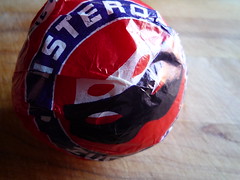 fig. a: masked marvel
fig. a: masked marvel
It started about six weeks ago. Yes, almost exactly six weeks ago. I was in Belgium on business and it was Carnival season.
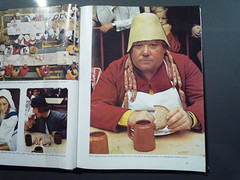 fig. b: carnivalesque
fig. b: carnivalesque
For the first few days it appeared to be mostly business as usual, although the train stations were like magnets for the costumed rowdies who descend upon Aalst every year, and, occasionally, you'd catch small glimpses of the carnivalesque elsewhere too.
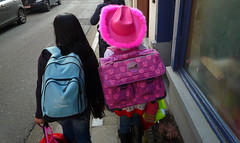 fig. c: Antwerp cowgirl
fig. c: Antwerp cowgirl
On Tuesday, March 8--Mardi Gras--I took up an invitation to check out le Carnaval de Binche, a Carnival hotspot of such significance that it's officially been named a Masterpiece of the Oral and Intangible Heritage of Humanity by UNESCO. I was pretty excited. I'd been familiar with Binche's mysterious Gilles for some time, and had wanted to experience its Carnival ever since. And, as it turns out, there was much more to the Gilles, and much more to le Carnaval de Binche than I could have possibly imagined. For one thing, Binche's Carnival is not just about the Gilles. While the Gilles have the biggest presence at Binche, and they're clearly the most revered of the revelers, there are a number of other processionals that make their way through the streets of Binche, including the Pierrots, the Peasants, and the Princesses.
 fig. d: masked marvels
fig. d: masked marvels
My first sighting of the Gilles lived up to expectations. This is the most highly publicized vision of le Carnaval de Binche--the one you see most commonly in guidebooks and on websites. What I didn't know, was that the distinctive masks are still handcrafted out of wax by one single artisanal mask-maker, that they're handed down from generation to generation, and, though many of Binche's Carnival customs date back to ancient times, this particular design dates back to the 19th century, and was modeled after Napoleon III, whose bourgeois-imperial style it was meant to parody.
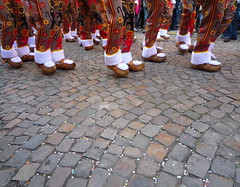 fig. e: men with clogs
fig. e: men with clogs
I also didn't realize that one of the reasons le Carnaval de Binche is so "intangible," is that it's essentially mute. The Gilles utter nary a word the whole day long, but the elaborate ceremonies are far from silent--they're accompanied by the sound of drumming and the constant, repetitive rhythm of the Gilles' clogging--the better to roust the the forces of springtime.
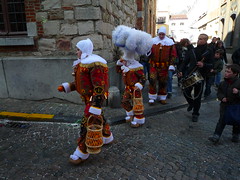
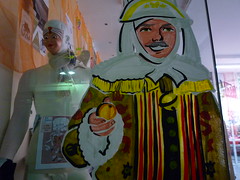 figs. f & g: Gilles with oranges
figs. f & g: Gilles with oranges
And, finally, I had no idea that after lunch the Gilles return with their masks removed, bearing elaborate plumed headdresses (this time modeled after Meso-American costumes that apparently left quite an impression on Renaissance-era minds), and that when they do, they also come loaded down with oranges. Blood oranges.
The oranges serve a dual purpose. On the one hand, they're used to express a little healthy iconoclasm. The Gilles became notorious for using their oranges to smash windows in the bourgeois central districts of Binche. These days, the windows of Binche are largely boarded up or otherwise protected in anticipation of Mardi Gras, but that doesn't stop the younger Gilles from launching oranges with full force against buildings, spraying the crowds with blood orange juice, and making people shriek. On the other hand, they're offered as a gift. The overwhelming majority of the oranges are gently tossed into the crowds so that people can collect them intact.

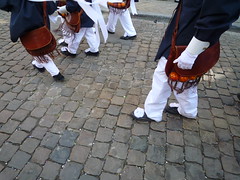 figs. h & i: orange luggage
figs. h & i: orange luggage
Either way--whether the Gilles intend to launch them violently, or toss them carefully--the blood oranges are hauled through the streets in attractive carriers. The Gilles use wicker hampers. The Peasants (les Paysans) use stylin' hand-tooled leather satchels. And hundreds and hundreds of extra oranges are carried by friends and family members in huge (and not particularly attractive) backpacks and duffel bags.
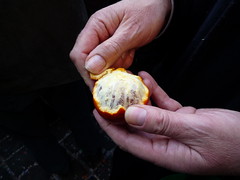 fig. j: on the street
fig. j: on the street
While the festivities last all day, and long into the night, the orange ceremony lasts just a couple of hours in the late afternoon. Still, you have plenty of occasion to eat some of your prizes on premises. And if you've got good hands, and you're smart enough to bring a bag, you can easily go home with a few dozen. Which is exactly what we did.

 figs. k & l: at home
figs. k & l: at home
We had them plain. We had them juiced. We had them in salad. We ate a lot of blood oranges over the next few days.
And when I got back to Montreal a week later, I was still hooked. So I started right up again with the blood oranges, this time with Michelle. Here in Montreal, I haven't been able to find the small Spanish ones that were featured at Binche (probably because the Carnaval cleaned them out), but, for a while there, there were plenty of blood oranges from California. The ones we like the most, though, are the ones from Sicily (the ones that come in the lovely wrappers with the masks on them, like the one you see up top). And those are still very much around, if you visit your better green grocers (we recommend Chez Nino, at Jean-Talon Market).
Again, we'll take blood oranges any way we can get them. We really can't get enough of their warm, rounded notes, and, besides, when they're gone, they're gone. But probably our favorite way of having them is in the form of suprêmes, in salad, with fennel.
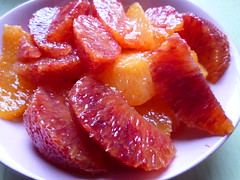 fig. m: suprêmes by Michelle
fig. m: suprêmes by Michelle
Not sure how to cut a blood orange (or any other citrus fruit, for that matter) into suprêmes? Here's a helpful how-to video, featuring the lovely and talented Michelle:
Now that you've prepared your suprêmes, here's a slightly modified recipe for a blood orange & fennel salad from good ole Mario Batali. After all, if you can't trust a self-proclaimed "fennel-holic," who can you trust?
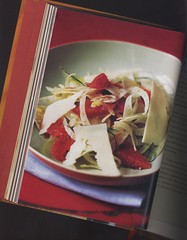 fig. n: blood oranges by batali
fig. n: blood oranges by batali
Blood Orange, Fennel, and Pecorino Salad
2 large round fennel bulbs, trimmed (make sure to save several fennel fronds)
juice of 1 lemon
1/4 cup extra-virgin olive oil
4 large blood oranges, preferably Sicilian
salt and freshly ground black pepper to taste
hard pecorino cheese, such as sardo or toscano, for shaving
Using a mandoline (carefully), shave the fennel crosswise into slices 1/3 of an inch thick. Place in a bowl and toss with the lemon juice and olive oil. Add the blood orange segments and fennel fronds and toss gently to mix. Season with salt and pepper.
Arrange the fennel salad on four individual plates. Shave the pecorino in long shards over each plate. Serve.
Note: Batali's original recipe calls for 1 cup of pomegranate seeds, but we haven't been adding them because it's not the season and the recipe is just great without them. Also, we sometimes replace the lemon juice with an equal amount of blood orange juice, if we have extra on hand. And, lastly, if you want to forego the pecorino--go ahead. The salad's just dandy with just oranges, fennel, olive oil, juice, salt and pepper.
[recipe based closely on a recipe from Mario Batali's Molto Italiano]
While we're at it, and there's still plenty of good citrus around, here's another orange recipe, albeit one that calls for conventional oranges, not blood oranges. It comes from a story on Sicily in the most recent issue of Saveur.
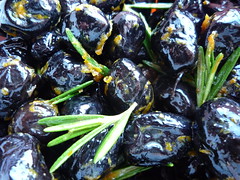 fig. o: ...is for oranges & olives
fig. o: ...is for oranges & olivesOliva con Rosemarino e Aranci
1 orange
1 lb dry-cured black olives
1 large sprig rosemary, stemmed and roughly chopped
freshly ground black pepper to taste
Wash the orange thoroughly, then dry it. Using a vegetable peeler or microplaner, remove the zest from the orange, taking care to peel as little of the pith as possible. Chop the zest and transfer to a medium bowl. Juice the orange and add the juice, the olives, the rosemary, and the pepper to the bowl. Toss to coat. Let sit at room temperature for at least an hour to marinate before serving.
[recipe from Saveur #136, March 2011]
And now that Lent is nearly over and Easter is just about here: both recipes would make an excellent addition to your Easter table. In fact, they'd go extraordinarily well with any kind of Mediterranean-style Pascal lamb.
aj
p.s. Many thanks to Obits for having dropped by and jammed a little while we cooked.








5 comments:
Not particularly astute, but: blood oranges are cooooooool lookin'.
love it, love it, love it... all of it, belgium, the masks, the video... what is that quick slice membrane dividing technique? Michelle, genius.
"Masterpiece of the Oral and Intangible Heritage of Humanity." Did you invent that or is it an actual category?
Michelle displays admirable dexterity with that orange.
I know what you mean, Amber--cool on the outside, cool on the inside--tasty, too
nice to hear from you, Stephen--I'm not sure that Michelle invented that QSMD technique, but she's pretty good at it
hi, Andrea--MOIHH is for real--check it out: http://www.unesco.org/culture/intangible-heritage/masterpiece.php--I'm not sure I'd be capable of coming up with such a designation--I'll pass on the compliment to Michelle
I like your video. Exceptionaly the little BoinG at the end.. :)
Post a Comment